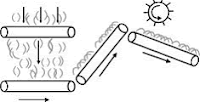YARN CONSTRUCTION
Basic Yarn Manufacturing Processes:
Carding –– Combing –– drafting –– twisting –– winding.
As the fibers pass through these processes, they are successively formed into: lap, sliver, roving and finally yarn.
The manufacturing operation in which these stages occurred
(1)Lap to card sliver by the lading process
(2)Card Sliver to Cone sliver by combing process.
(3)Shiver to roving by the drafting, or drawing out process
(4)Roving to yarn by further drafting and twisting process.
(5)Yarn reeled on bobbins, spools or cones by the winding process.
(1) Bending, Ending, Opening and Cleaning:
(i) The cotton arrives at the mill in large bales weighing about 500 pounds / 225 kg. The compressed mass of raw fibers must be removed from the bales, blended, opened & cleaned.
(ii) Opening is necessary in order to loosen hard lumps of fibers & disentangle them.
(iii) Cleaning is required to remove trash – such as dirt, leaves, burrs, seeds, etc.
(iv) Blending is necessary to obtain uniformity of fiber quality.
(v) Blending: Mechanical bale pickers pluck thin, even layers of the matted fiber from each of a predetermined number of bales in turn and deposit them on Hooper. The fiber is mixed & passed to an opener.
(vi) Opening: As the mass of fiber passes through the openers, cylinders with protruding fingers open up the lumps & free the trash. The number & kind of cylinder, or beaters, employed depend upon the type of cotton that is being processed.
(vii) Cleaning: As the cotton is opened, trash falls through a series of grid bars. When the cotton emerges from the opener, it still contains small tuffs with about 2/3rd of trash.
(vii) This may be conveyed as a lap, which is loosely entangled mass about 1" thick and about 40" wide. Or it may be fed by chute directly to the card for further cleaning and fiber separation.
 |
| Blending |
 |
| Opening and Cleaning |
(2) Carding:
(i) This is the process of arranging the fibers in a parallel fashion. This is necessary for all staple fibers; otherwise, it would be impossible to produce fine yarns from what is originally a tangled mass.(ii) Before the raw stock can be made into yarn, the remaining impurities must be removed, the fibers must be disentangled, and they must be straightened.
(iii) The lap is passed through a beater section and drawn on a rapidly revolving cylinder covered with very fine hooks or wire brushes.
(iv) A moving belt of wire brushes slowly moves concentrically above this cylinder. As the cylinder rotate, the cotton is pulled by the cylinder through the small gap under the brushes, the teasing action remove the remaining trash, disentangles the fibers and arranges them in a relatively parallel manner in the form of a thin web.
(v) This web is drawn through a funnel – Shaped device that molds it into a round ropelike mass called the card sliver (about thickness of a broom stick).
 |
| Carding |
(3) Combing:
(i) In this operation, fine-toothed combs continue straightening the fibers until they are arranged with such high degree of parallelism that the short fibers called ‘noils’ are combed out and completely separated.
(ii) This procedure is not done when processing man-made staple fibers because they are cut into predetermined uniform length.
(iii) This operation eliminate, as much as 25% of the original card sliver, thus almost one-fourth of the raw cotton becomes waste.
(iv) The combing process forms a comb sliver made of the longest fibers, which, in then, produces a smoother & more even yarn.
(i) In this operation, fine-toothed combs continue straightening the fibers until they are arranged with such high degree of parallelism that the short fibers called ‘noils’ are combed out and completely separated.
(ii) This procedure is not done when processing man-made staple fibers because they are cut into predetermined uniform length.
(iii) This operation eliminate, as much as 25% of the original card sliver, thus almost one-fourth of the raw cotton becomes waste.
(iv) The combing process forms a comb sliver made of the longest fibers, which, in then, produces a smoother & more even yarn.
 |
| Combing |
(4) Drafting / Drawing
(i) The draw frame has several pairs of rollers, each advance set of which revolves at a progressively faster speed.(ii) This action pulls the staple lengthwise over each other, thereby producing longer & thinner slivers.
(iii) After several stages of drawing out, the condensed sliver is taken to the slubber, where rollers similar to those in the drawing frame draw out the cotton further.
(iv) The slubbing is passed to the spindles, where it is given its first twist & is then wound on bobbins.
 |
| Drawing |
(5) Roving:
(i) Roving is the final product of several drawing out-operation.
(ii) These bobbins are placed on the roving frame, where further drawing out and twisting take place until the cotton stock is about the diameter of a pencil lead
(iii) To this point, only enough twist has been given the stock to hold the fibers together.
(iv) Roving has no tensile strength, it will break apart easily with any slight pull.
(i) Roving is the final product of several drawing out-operation.
(ii) These bobbins are placed on the roving frame, where further drawing out and twisting take place until the cotton stock is about the diameter of a pencil lead
(iii) To this point, only enough twist has been given the stock to hold the fibers together.
(iv) Roving has no tensile strength, it will break apart easily with any slight pull.
 |
| Roving |
(6) Spinning:
(i) The ring spinning frame complete the manufacture of yarn
• By drawing out the roving
• By inserting twist
• By winding the yarn on bobbins.
(ii) Ring Spinning draws; twist s& winds in one continuous process. The traveler carries the yarn as it slides around the ring, thus inserting the twist.
No comments:
Post a Comment